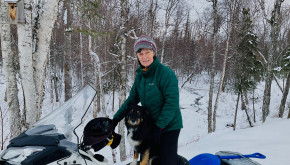
This is the first in a series of WOW Entomology publications by Molly Norton Darr and Leonora Pepper. Each publication will highlight a common insect impacting forests in a particular region of the United States, paired with an interview of a woman landowner who has had to address that insect in managing her forest.
Please check out the full publication!
Donna Massay lives on eleven forested acres on a lake situated three hours north of Anchorage, on the south side of the Alaska Range. Her mixed spruce and birch forest is alive with wildlife: moose, bears, spruce grouse, coyotes, minx, beavers, otters, ducks, owls, hawks, and eagles. Originally from New Hampshire, Donna moved to Alaska in 1968 and competed in the 1980 and 1981 Iditarod. These days, she walks her property in all seasons, observing changes in the land. Recently, she has had to face more changes than she’d like, as the past four years have brought spruce beetle infestations. Watching most of the mature spruce trees in her forest succumb to the beetle, Donna has learned to steward her land with an eye to mitigating the damage, and in doing so is seeing some silver linings in the recovering forest.
Donna's forest stewardship approach
My home site is developed and Firewise, but the rest of the land is minimally "enhanced". I maintain but don't disturb the game trails. I've tried to promote nesting areas, and I leave birch snags for nesting habitat. Some brush I burn, but some I leave for ground-nesting birds. With any forest management I do, I ask myself, “How can I do this so it benefits the critters?”
I use 3 cords of wood per year to heat the house, so my management plan includes firewood harvest for personal use, which my eleven acres can sustain. I do the felling and bucking with a chainsaw. For firewood, I look for a mix of spruce (faster burn and kindling) and birch (longer lasting fire). Now, with the beetle dieback, I’m burning a lot of spruce. In taking them down, I’m selective so as not to damage the understory. There are lots of small trees in the understory waiting for their opportunity!
Spruce bark beetle impacts
The spruce bark beetles took out all the trees over 4" in diameter--they hit everything. After the beetle hatch in June, the spruce trees turned reddish brown and were dead in a couple of months. Just to keep my home Firewise, I’ve had to cut down more than one hundred trees. We’ve had a spruce bark beetle outbreak every year for the past four years; they've always been around and historically, but now, with the warmer summers, it may be a cycle that stays with us.
Right now I see recovery. The question is whether, when they get to be 8-10 inches, we’ll see another wave of infestation come through. In the meantime, I’m seeing a lot of white birch coming in, and in the understory more grasses, soapberry, and ground-creeping black currents. With these low-growing food sources more plentiful, in the past couple of years the population of ground critters (voles, mice, shrews) has taken off, which has led to more small hawks and birds of prey hunting the forest—especially in more open forest where I’ve harvested the dead standing trees.
It’s amazing, with the older trees gone, to see the rapid growth in younger trees.
Advice to other landowners
At first it was devastating to see the trees dying—the sheer scale of it was overwhelming. My advice is to set your goals small based on what’s most important, like keeping your buildings safe and reducing fire risk. Instead of saying "I need to harvest 11 acres of standing dead spruce", decide on a small area to start with, and from there move on to tackle other areas. Working with a forester helped me define the priority areas.
My forester helped me develop a way to adapt to the changing woods and encourage a recovery outcome that will improve the woods without changing their character. I’m amazed at how rapidly younger trees are growing. I miss the stately old spruce, but there is a vibrancy in the younger trees that’s pretty neat!
Spruce bark beetle
We invite you to explore the linked entomology publication for information on the beetle's impacts, life stages, geographic range, and signals by which to identify it on your property--as well as the forest management implications of its presence.
Please follow this link for the full interview with Donna and a spruce bark beetle fact sheet!

